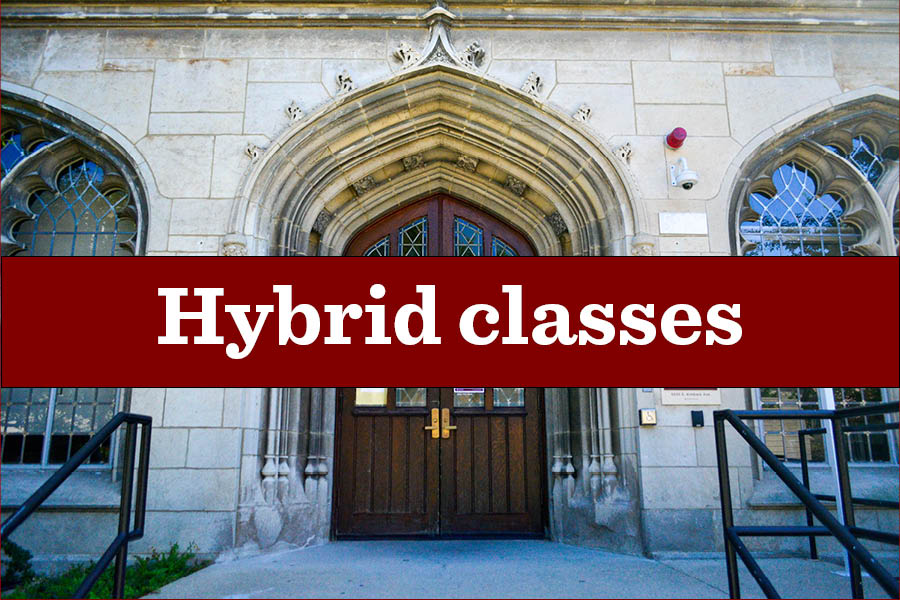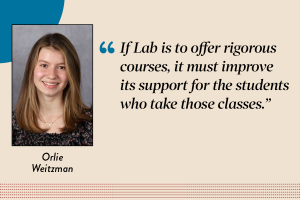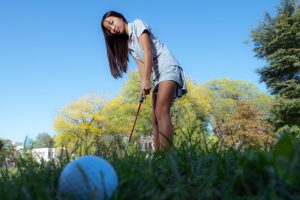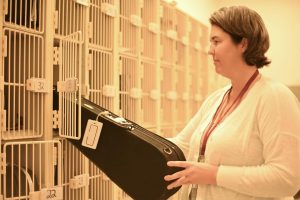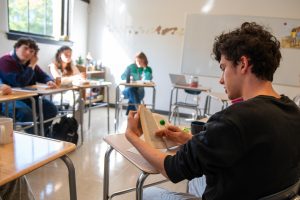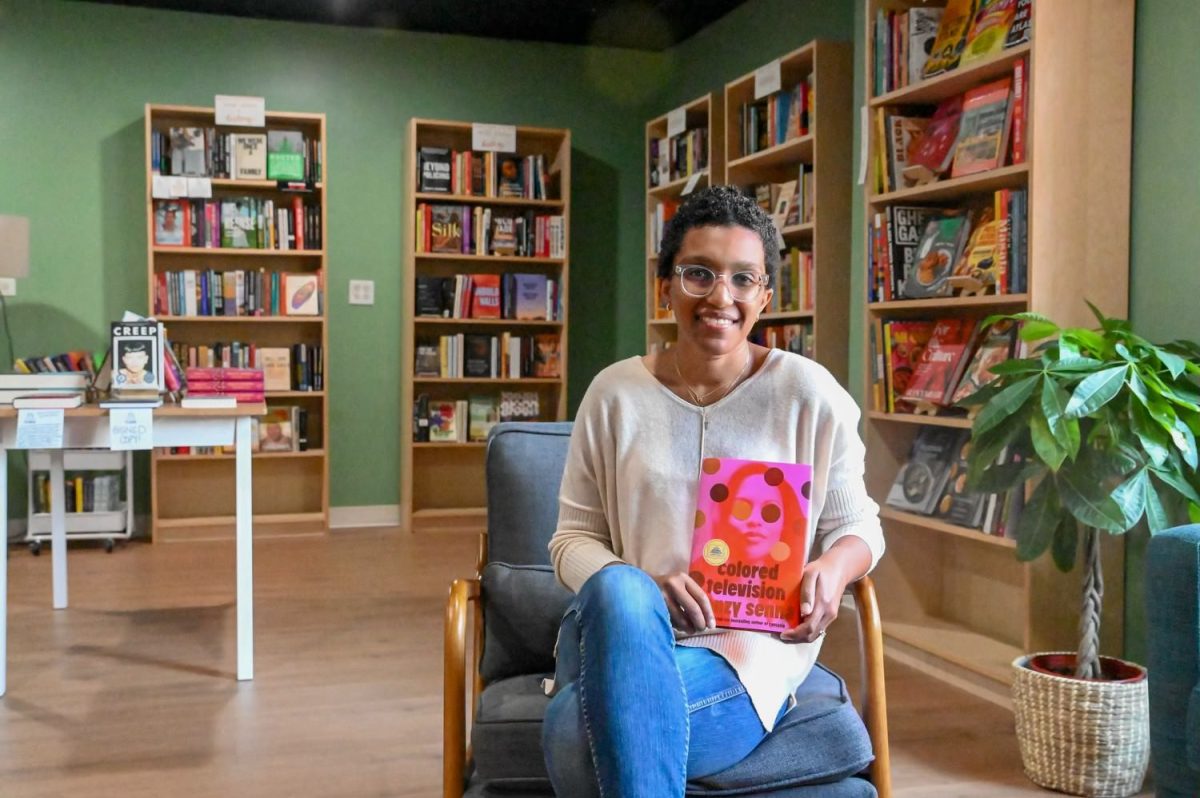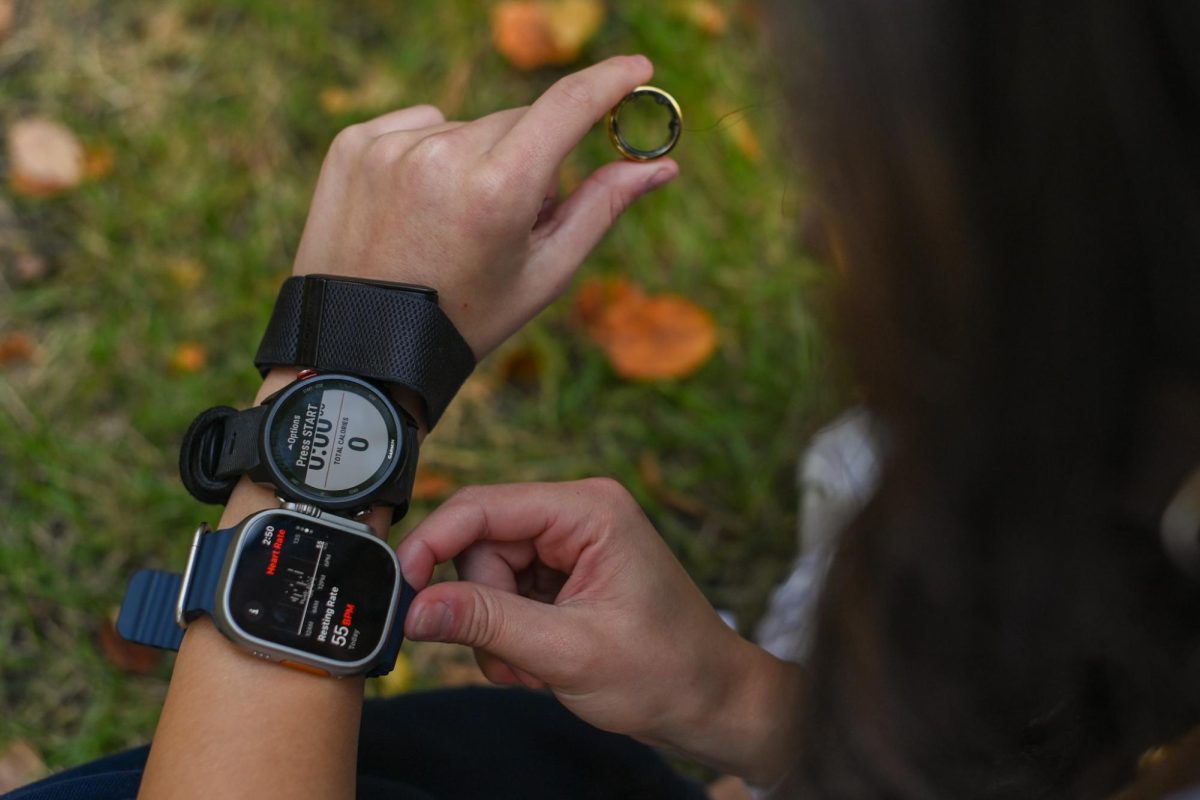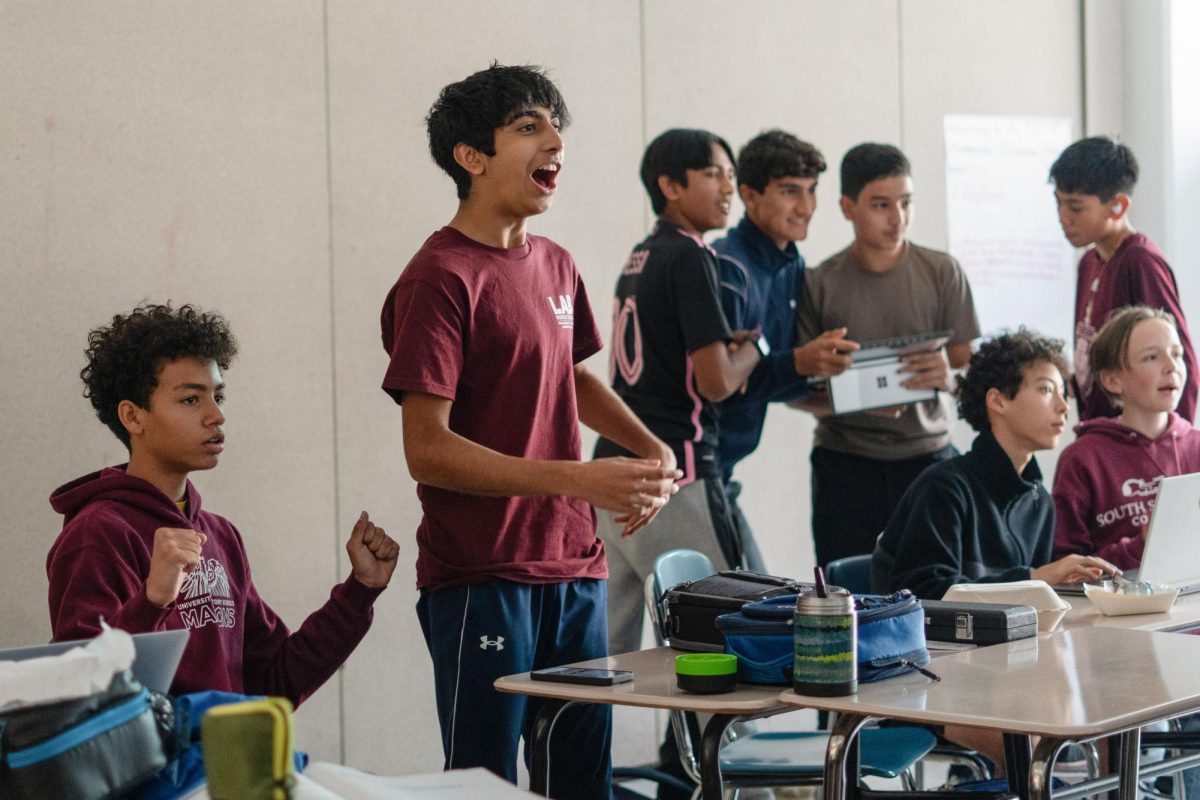Department updates: Teachers share how classes will look during hybrid learning
March 7, 2021
Hybrid learning begins March 8 with 60% of the seniors choosing to spend two days attending classes in person. The Midway has compiled interviews with teachers representing most departments about what they expect in-person learning to look like and how distance learning will change. Some departments were unable to be contacted by publication deadline. This story will be updated.
Computer Science — Jeremy Schwartz
How do you anticipate the return to in-person school affecting computer science department?
The computer science curriculum will remain largely unchanged. Since many of the classes have different-aged students, students will never be all together when in-person. In-person students will have no significant advantages in terms of access to hardware in the rooms. While in-person students will be in the computer lab, remote students will be able to complete assignments from home using their own computers. According to Mr. Schwartz, “For equity and accessibility, we want to make sure our students at home or at school still have the tools that they need and the resources to complete assignments.”
How is your department adjusting your classes so that students can participate while remaining socially distant?
The department is unsure of the final layout of their classrooms and are therefore encouraging students to bring their laptops to school with them. “If you need to be in a situation where a fixed desktop computer isn’t comfortable or safe in terms of social distancing requirements, students can use their laptops which have a bit more flexibility in the room,” Mr. Schwartz said.
What are some issues your department anticipates having?
“One of them has to do with hygiene,” said Mr. Schwartz. “Other classes are going to be using the computer lab, and the computers, keyboards, and mice are high-touch contact surfaces. It’s not just like sitting at a desk, you’re actually putting your hands somewhere where someone else put their hand.” The computer science teachers will need to make sure their students are responsible when it comes to maintaining a sanitized classroom environment.
What will computer science look like for students who stay remote?
“Our initial plan is to keep the plan and the rhythm we’ve already established,” Mr. Schwartz said. Students who are staying remote will still be able to find their materials and assignment details in Schoology. In most classes, in-person students will also be connecting to the meeting software, so remote students can interact with their peers as well as their teachers.
English — Mark Krewatch
How do you anticipate the return to in-person school affecting the english department?
Mr. Krewatch said he is unsure how discussions will work, but he is willing to try them. He said his classes may still have to do breakout rooms and combine individuals who are at home with those who are in the classrooms. “So as opposed to a breakout room where I don’t know what’s happening in the other rooms when I’m in one, I can actually walk around the room and know that these two students over here are talking to that student at home,” Mr. Krewatch said. “Then I can hear a conversation that I know a student at home is engaged with.”
What are some issues your department anticipates having?
Mr. Krewatch is concerned with being heard and seen with a mask on, particularly when it comes to facial expressions and tone. According to Mr. Krewatch, tone is already hard when talking about a book or a character, and if a student misinterprets someone’s tone, or one is not clear in projecting the tone that they have when addressing something, then students can take that the wrong way, which may become problematic. He believes that individuals must be clear in what they are saying because it can be difficult to get things across when an individual’s face can’t be seen. “In an English class it can be really hard to say the right thing, when there’s socio-political overtones to the characters that you’re talking about,” Mr. Krewatch said. “You’ve heard me talk about that and other teachers talk about how when they’re setting up difficult conversations, like how are we going to do this? That’s going to be harder with a mask on for sure.”
What will class look like for students who stay remote?
At the start of hybrid learning, Mr. Krewatch’s strategy will be to continue to have people tied into Zoom but have them connected with people at home in ways that people at home are talking to students in the classroom. While Mr. Krewatch is excited for those students who will have the benefit of feeling like they are in a classroom through the hybrid model, he still must take care of those students who remain at home. “Personally, I don’t want to put kids that are at home in one group and kids that are in the classroom in another group, because the equity of that seems potentially nonexistent,” Mr. Krewatch said. “What we don’t want is kids who have to stay home for really legitimate reasons, getting a lesser educational experience than the people in the room.”
Are you planning on adapting your curriculum in any way?
According to Mr. Krewatch, changes have already been made in the English classes that he teaches. For example, he finds it unlikely that “Frankenstein” will be taught in the Expository class, and he plans to assign a lot more papers that are shorter in length. The department is trying to continue to keep basic core skills such as inferential thinking, clear paragraph writing, exploratory writing and responsive writing when looking at different ways that one can enter a text.
Art — Sunny Neater
How do you anticipate the return to in-person school affecting the art department?
For many classes, students who are completely remote will have much more flexibility for projects. Ms. Neater said, “We want students who are in person to be able to take advantage of the resources, and we want students who are remote to really also have a robust experience, so we might have two parallel projects going on within each class.”
How is your department adjusting your classes so that students can participate while remaining socially distant?
Since art classes are composed of students in every grade, there is less of a concern of overcrowded classrooms. Additionally, the tables are on casters so they move around easily and the classrooms are large so maintaining social distancing is not an issue. Ms. Neater said, “We have a lot of time at the start and at the finish of each class to spray down our workspaces and sanitize both the workspaces, and wipe down the [materials] with sanitizing wipes.”
What are some issues your department anticipates having?
“I think it will be a little chaotic the first time each grade level cycles through,” Ms. Neater said. “Hopefully people will be very gracious with each other, not only with the anxiety, confusion, fear and excitement about seeing each other.”
What will class look like for students who stay remote?
The art department is working to ensure an equitable and interesting experience for students who are completely remote.
History — Charles Disantis
How do you anticipate the return to in-person school affecting the history department?
While Mr. Disantis, history teacher, is unable to speak for every history class, he thinks there will be a lot of trial and error in terms of how things will actually operate for his classes. He is aiming to use class time for things that can’t be easily replicated in a remote environment through keeping things such as quizzes during the remote times. Additionally, he wants to ensure that students who stay remote are still getting the attention they need and deserve. He said, “Trying to figure out what tech setting works the best, trying to figure out how to facilitate discussions in a way that incorporates both groups are all things we’ll need to work through, and I’d say those things apply to the entire department as well.
How is your department adjusting your classes so that students can participate while remaining socially distant?
According to Mr. Disantis, the challenge will be to balance routine through keeping the same types of things that have been done before, while also trying to make the most of the time spent in person. In terms of staying socially distant during class time, Mr. Disantis said it won’t be challenging as long as students do their part to follow the guidelines about how to enter and leave class as well as keeping a six-foot distance with one another.
What are some issues your department anticipates having?
Despite the short period of planning time given, Mr. Disantis feels as if the administration’s thoughtfulness about rooms and spaces and their clear communication about safety and health guidelines when people are in school has made many teachers more confident, making him not have much to worry about. “There’s a touch of worry about how things are going to go given that it will be nearly a year since I’ve been out of the classroom, and probably a lot of people are feeling that, I would imagine,” Mr. Disantis said. “But there’s also the desire to come back and see students directly again.”
Are you planning on adapting your curriculum in any way?
Mr. Disantis said he would have to start making some changes in his own curriculum and reconsider the amount of work that is done in preparation for classes, since students are adjusting to a new environment. He said he will try to take things at a slightly slower pace and try to have a bit less done on a daily basis. He said, “There will be changes just because I think in any major shift you need to be cognizant of students who are dealing with that that shift in the way that they attend school.”
Journalism — Logan Aimone
How do you anticipate the return to in-person school affecting the journalism department?
Since most of the work is already done asynchronously, the journalism department plans on keeping the same pattern as they have all year. Mr. Aimone said he finds that it will be more helpful to do collaborative projects in person, especially when producing and designing the printed paper. Additionally he stated that yearbook staff will have access to computers in the classroom, which are more powerful and faster than the computers that they’ve been using at home.
How is your department adjusting your classes so that students can participate while remaining socially distant?
The only adjustment will be enforcing social distancing in the classroom by limiting where people can sit. While students wouldn’t normally be working shoulder to shoulder, Mr. Aimone said the computer lab will feel a lot different because students won’t be able to sit next to each other when doing page design.
What are some issues your department anticipates having?
According to Mr. Aimone, the journalism department will face the same kinds of challenges that all other students and teachers are going to face. He said, “I just think it’s something we need to experience and figure out how to adjust, but I feel very good about what Ms. Rumble and I have done in journalism with being able to structure our classes in ways that students can work synchronously and asynchronously, that we’re not relying on those classroom meetings and synchronous times as much as we have in the past.”
What will classes look like for students who stay remote?
Mr Aimone thinks there might be some feelings of separation for the distance learners when class discussions occur. However, Mr. Aimone has been sensitive in ensuring that the students who are not in the classroom have a positive experience. He said, “So the sort of basic experience will be one that is a solid experience online, and then the benefit comes from just seeing other people in the classroom and the chit-chat before and after class and that sort of thing.”
Are you planning on adapting your curriculum in any way?
Since most of the work can be done asynchronously, the curriculum will probably stay the same. Mr. Aimone said he doesn’t think returning to hybrid learning will make much of a difference considering that the same schedule will be kept.
Learning and Counseling — Lesley Scott
How do you anticipate the return to in-person school affecting the L&C Department?
Making an appointment is the same process as in distance learning. The learning and counseling department cannot take drop-ins for contact tracing purposes. Ms. Scott said, “School counselors will be on campus for all ninth and 10th grade in-person days, and then they’re on a rotating schedule for the 11th and 12th grade in-person days. College counselors will be on campus the 11th and 12th grade in-person days, and then learning coordinators will be on campus when the grade level they support is in person.”
If in-person students prefer, they can continue to meet department members over Zoom rather than in person. C131 and C134 will have workspaces available to students to study quietly and charge computers. Additionally, there will be spaces for students experiencing a panic attack or crisis where they can use the support of the learning and counseling department.
How is your department adjusting your classes so that students can participate while remaining socially distant?
“Of course, we’ll be meeting the six-foot distance in our office spaces, and so some of that requires furniture removal, to make sure that that distance is met,” Ms. Scott said. “Obviously everyone has the same safety protocols. Every one in a mask. People should be washing their hands or using hand sanitizer upon entry and exit.”
What are some issues your department anticipates having?
“Because our schedules are all intermixed who we might be working with mostly on a day, so imagine this school counselor would work ninth through 12th grade.” Ms. Scott said. “And so even if they’re in person, they’re also zooming with people who are not on campus, zooming with people who are remote, and then meeting with people who are in person, and then thinking about programmatically also deliver services.”
What will classes look like for students who stay remote?
Students who remain remote should make appointments as they have all year and department members will be available via Zoom.
Here is an FAQ with more information.
Will L&C programming change?
Learning and Counseling programming will remain remote and on Wednesdays.
Math — Will be updated when available
Music — Will be updated when available
Physical Education — Scott Budeselich
How do you anticipate the return to in-person school affecting the P.E. department?
The P.E. curriculum will remain largely unchanged and classes will continue to focus on health and wellness, diversity, equity and inclusion, social-emotional health and body systems. Part of class time will be spent doing fitness and part will be discussion-based. The department hopes that P.E. can be a space where students can have fun and be creative while also getting to work as a team with classmates. According to Mr. Budeselich, “We don’t want to say we’re back in school and then it’s all individual.”
How is your department adjusting your classes so that students can participate while remaining socially distant?
Students will sanitize their hands on the way in and way out. Mr. Budeselich said, “We are going to do as much outside as we can with all the classes third to high school. But then indoors, if we have our spaces, we should be able to distance and spread out.”
What are some issues your department anticipates having?
According to Mr. Budeselich, teachers might have personal microphone on them and speakers so that they can talk to their class without yelling.
What will classes look like for students who stay remote?
The P.E. department is working to ensure that the remote and hybrid programs are equitable. Mr. Budeselich said, “I definitely feel like, P.E.-wise, we want to make sure that we are doing things the right way for every student whether they’re here or at home.”
Will students change in locker rooms?
“We are gonna probably not have the locker room space, because it’s so tight and there is going to be a lot of people in there,” Mr. Budeselich said. “So we’re also aware that we’re not going to try to get all super-sweaty in their school clothes that they have to go back to class and finish their day in.”
Science — Zachary Hund
How do you anticipate the return to in-person school affecting the science department?
Dr. Hund said the science department is, “trying to find a balance of how much more curriculum do I cover, versus ‘Hey we haven’t really been able to do any experiments, how do we get in and actually do science right now?’ So I think it’s, it’s going to be very much teacher-dependent on what the class is going to look like.”
How is your department adjusting your classes so that students can participate while remaining socially distant?
For labs, Dr. Hund anticipates only 12 students will be able to participate at any time which could be a problem for larger classes. “So what happens if I have 16 juniors coming back in a given day, or 18 sophomores,” Dr. Hund said. “What am I supposed to do? Because it becomes very awkward to not only balance, potentially remote students, in-person students at desks and in-person students doing labs.”
What are some issues your department anticipates having?
“For the most part science teachers, teachers in my department are excited,” Dr. Hund said. “I think historically our department’s been really close to the students and we’ve had great relationships with those who we teach. I think there’s still a level of caution to make sure that we’re doing this the right way to make sure that the right plans and policies, and just logistics are in place.”
What will classes look like for students who stay remote?
“I might set up a web camera that just is focused on a lab bench and for those students who are remote, who want to observe the lab in person and they can talk to the lab group,” Dr. Hund said. “Again, it depends on how many students are remote because if there’s 10 students on Zoom, trying to watch two students at a lab bench and all 10 are trying to talk and be involved it’s just messy.”
What is the department planning on doing for labs and experiments?
For smaller classes, Dr. Hund anticipates labs and experiments will be possible. However, Dr. Hund said that larger classes might have to watch demonstrations rather than complete labs themselves.



